Brazilian real
| real | |
|---|---|
| Country: |
|
| Subdivision: | 100 centavos |
| ISO 4217 code : | BRL |
| Abbreviation: | R $ |
|
Exchange rate : (August 24, 2020) |
1 EUR = 6.5941 BRL 1 CHF = 6.1278 BRL |
The real (plural in German real , in Portuguese reais ) has been the currency of Brazil since 1994 . From 1690 to 1942 the Brazilian currency was also called the real , the plural at that time was Réis .
The sub-unit of the real is the centavo (100 centavos = 1 real). The real was introduced in 1994 in place of the cruzeiro in Brazil after a period of high inflation . Its value was initially controlled by the Brazilian central bank, but has been freely traded on the capital market since 1999.
The publisher is the Central Bank of Brazil .
History of the Brazilian currencies
The first Portuguese settlers in America used the Portuguese real as a currency. However, the first official money, called real, was introduced and printed by the Dutch in 1654 , during the occupation of northeastern Brazil. In 1790, the real became the official Brazilian currency. Between 1942 and 1994, the currency that had been devalued by inflation was replaced by a new currency of higher value six times :
| time | currency | Subunit | Exchange rate |
|---|---|---|---|
| 1690-1942 | real | ||
| 1942-1967 | Cruzeiro | 100 centavos | 1000: 1 |
| 1967-1970 | Cruzeiro novo | 100 centavos | 1000: 1 |
| 1970-1986 | Cruzeiro | 100 centavos | 1: 1 |
| 1986-1989 | Cruzado | 100 centavos | 1000: 1 |
| 1989-1990 | Cruzado novo | 100 centavos | 1000: 1 |
| 1990-1993 | Cruzeiro | 100 centavos | 1: 1 |
| 1993-1994 | Cruzeiro real | 100 centavos | 1000: 1 |
| since 1994 | real | 100 centavos | 2750: 1 |
A real from 1994 is thus worth 2,750,000,000,000,000,000 (2.75 trillion) old Réis.
In Brazil in 1994 the real (BRL) replaced the previous currency "Cruzeiro", which in 1942 had replaced the real used since 1690. Today 100 centavos is a real. After several periods of hyperinflation and currency reforms, the real was introduced in 1994 with an original value of US $ 1 . In January 1999 the country got into a currency crisis, which led to a sharp devaluation of the real and then to a general economic crisis. A release of the currency became necessary. Inflation has been brought under control through the creation of a political framework and economic reforms. According to the International Monetary Fund ( IMF ), the inflation rate was 6.9% in 2005 and 4.2% in 2006. For 2007, the estimates were 3.5%.
The 2014 World Cup and the 2016 Summer Olympics in Brazil have seen a sharp rise in prices in many areas of life since spring 2014. Many Brazilians are protesting with a parallel currency called “surreal” against the increase in price, which is perceived as inappropriate.
Plano Real
On January 7, 1994, a new currency was put into circulation in Brazil, the real. In the course of the currency reform that became known as Plano Real , it was possible to end the chronic inflation that dominated the country and its economy and to continuously lower the remaining inflation in the following years. It was not until then Finance Minister Fernando Henrique Cardoso succeeded in March 1994 with the "Plano Real" to create a solid basis for constant economic growth and price stability . The “Plano Real” had its effect right from the start: inflation fell from 50% per month (June 1994) to below 2% on an annual average, with significant economic growth at the same time. For the first time in many years, the poor Brazilians in particular were able to enjoy increasing real incomes.
1999 currency crisis
Brazil experienced strong inflation in the 1980s and 1990s, which was accompanied by nominal devaluation. As a result, a stabilization program was decided in 1993. a. a new currency, the real, was introduced in July 1994. The real was supposed to be devalued in a controlled manner against the US dollar ( crawling peg ), but it was still considered nominally overvalued. Brazil thus recorded a significant current account deficit, which was financed by short-term capital flows. When there was no inflow of capital and capital flight began (currency run), the real had to be devalued drastically by around 50% in January 1999, despite an international aid package of 40 billion US dollars under the leadership of the International Monetary Fund. After the crisis, there were further devaluations of the real. The Brazilian currency was only able to stabilize in 2003.
Banknotes
The current banknotes were put into circulation in 1994 at 1, 5, 10, 50 and 100 reais. Two more banknotes were added a few years later: the 2-reais banknote was issued in 2001 and the 20-reais banknote in the following year. As of 2006, the 1-real banknote was no longer printed and disappeared from circulation, but is still valid.
Commemorative banknote
In April 2000, the Banco Central do Brasil issued a 10 reais commemorative banknote on the occasion of the 500th anniversary of the discovery of Brazil. This appeared as a polymer banknote, but is no longer put into circulation because the high production costs are not in relation to the very rapid wear and tear (loss of color on the integrated plastic part). The design is more complex than with conventional paper banknotes.
- front
- Portrait of Pedro Álvares Cabral , a Portuguese navigator, one of the explorers of Brazil
- Representation of the map "Terra Brasilis", one of the earliest map representations of Brazil
- a section from the letter of Pero Vaz de Caminha to King Manuel I of Portugal
- a Portuguese wind rose from the 16th century
- on the upper right-hand side, ships from Cabral's expedition appear if you hold the bill up to the light
- in the background decorative elements made of Portuguese tiles can be seen
- the white area around the red point is transparent (the red point is translucent)
- in the background is the cross of the Knights Templar , which was present in all Portuguese ships at that time
- back
- Map of Brazil with photographs of the ethnic diversity of the Brazilian people (white, black, Indian)
New series of banknotes from 2010
The Brazilian central bank has been issuing a second series of banknotes since 2010, starting with notes over 50 and 100 reais. The motifs and colors are similar to the previous notes, but the new series has different sizes for the various values and has clear markings for the visually impaired. In addition, new security features have been introduced, such as holograms (R $ 50 and R $ 100) and special inks with a tilting effect from blue to green (R $ 10 and R $ 20). The previous banknotes are still valid, but will be withdrawn gradually.
Coins
There are coins of 1, 5, 10, 25 and 50 Centavos and 1 Real. In 1998 a second coinage was put into circulation, which differs from the first one in terms of material and motifs. The euro coins put into circulation four years later resemble real coins in terms of size, appearance and material properties. On December 23, 2003, the Brazilian central bank decided to take the first 1 real coin out of circulation. The coins for one centavo have practically disappeared from circulation. Prices at the checkout are rounded up or down to 5 Centavos. Production of the 1 centavo coin ceased in November 2005. A 5 reais coin planned for 2009 is not yet in circulation.
First coinage
| Face value | Illustration | motive | material | Weight | diameter | thickness | edge | |
|---|---|---|---|---|---|---|---|---|
| 1 cent |

|
Portrait of the Republic | stainless steel | 2.96 g | 20 mm | 1.2 mm | smooth | |
| 5 cents |

|

|
Portrait of the Republic | stainless steel | 3.27 g | 21 mm | 1.2 mm | smooth |
| 10 cents |

|
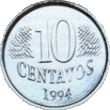
|
Portrait of the Republic | stainless steel | 3.59 g | 22 mm | 1.2 mm | smooth |
| 25 cents |

|
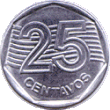
|
Portrait of the Republic | stainless steel | 4.78 g | 23.5 mm | 1.4 mm | smooth |
| 50 cents |

|
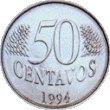
|
Portrait of the Republic | stainless steel | 3.92 g | 23 mm | 1.2 mm | smooth |
| 1 real |

|

|
Portrait of the Republic | stainless steel | 4.27 g | 24 mm | 1.2 mm | smooth |
Second coinage
| Face value | Illustration | motive | material | Weight | diameter | thickness | Edge inscription |
|
|---|---|---|---|---|---|---|---|---|
| 1 cent |

|

|
Pedro Álvares Cabral (1467–1526), Portuguese navigator | copper-plated steel | 2.43 g | 17 mm | 1.65 mm | smooth |
| 5 cents |

|

|
Joaquim José da Silva Xavier (1746–1792), who was hanged for his involvement in the early independence movement | copper-plated stainless steel | 4.1 g | 22 mm | 1.65 mm | smooth |
| 10 cents |

|
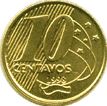
|
Dom Pedro I (1798–1834), Brazil's first emperor | stainless steel plated with bronze | 4.8 g | 20 mm | 2.23 mm | corrugated |
| 25 cents |

|

|
Manuel Deodoro da Fonseca (1827-1892), Brazil's first republican president | stainless steel plated with bronze | 7.55 g | 25 mm | 2.25 mm | corrugated |
| 50 cents |

|
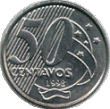
|
José Maria da Silva Júnior Paranhos (1845–1912), Brazilian statesman, diplomat and historian |
Cupronickel 1998-2001 |
9.25 g | 23 mm | 2.85 mm | ORDEM E PROGRESSO |
| Stainless steel from 2002 |
6.8 g | 23 mm | 2.85 mm | ORDEM E PROGRESSO | ||||
| 1 real |

|

|
Portrait of the Republic |
Ring: Alpaca Kern: Kupfernickel 1998–2001 |
7.48 g | 27 mm | 1.95 mm | corrugated |
|
Ring: bronze plated stainless steel Core: stainless steel from 2002 |
7 g | 27 mm | 1.95 mm | corrugated | ||||
Security features of the banknotes
| No. | Security feature | Illustration | description |
|---|---|---|---|
| 1 | Watermark |  |
If the banknote is held up to the light, the image of the republic becomes recognizable. |
| 2 | Colored fibers |  |
Red, blue and green fibers can be seen on both sides of the banknote. |
| 3 | Gravure printing |  |
By using the intaglio printing process, a tactile relief is created on the front. The words "CENTRAL BANK OF BRAZIL" and "EMC REAL" stand out noticeably. |
| 4th | fine lines |  |
Straight and winding, extremely thin lines all over the banknote |
| 5 | Micro- writing or micro- printing |  |
With the help of a magnifying glass, the tiny letters “B” and “C” next to the portrait (front) and in the 100 (front and back) can be seen in some places on the banknote. |
| 6th | See-through register |  |
The see-through register is a feature on the right side (front) of the banknote. Irregular characters printed on the front and back of the banknotes form a complete picture when backlit. |
| 7th | Security thread |  |
The banknotes have a security thread that is embedded in the paper approximately in the middle of the banknotes and is visible against the light. A dark line runs across the entire width of the banknote. |
| 8th | Serial numbering |  |
The numbering consisting of letters and numbers is used to identify the banknote. Series represents the design of the banknote. Ordem (order) is the sequential number. Estampa describes the series with similar graphics. |
| 9 | Latent image |  |
When looking at the note from a certain angle, the letters “B” and “C” appear in the lower left corner of the front. |
| 10 | Tast marks (gravure) |  |
To support the visually impaired so that they can distinguish the value of the banknote. |
| 11 | Fluorescent fibers |  |
Fluorescent fibers can be seen on the front and back when the banknote is held under ultraviolet light. |
| 12 | Micro-signatures |  |
Very small signatures from the Minister of Finance and the President of the Brazilian Central Bank are on the front. |
Web links
- Internet presence of the Brazilian central bank Banco Central do Brasil
- Christoph Ulmer: The "Plano Real" - a success story without a happy ending? About the need for structural reforms. In: Advanced seminar for students of the master’s degree in political science. University of Tübingen , 1999, archived from the original on April 12, 2012 ; accessed on July 31, 2016 .
- Elementos de Segurança do Real. Banco Central do Brasil, accessed November 29, 2009 (Portuguese, security features of Brazilian banknotes).
Individual evidence
- ^ Banco Central do Brasil: Money in Brasil . Retrieved November 29, 2009.
- ↑ goldman-sachs.ch: Brazilian real . Retrieved November 25, 2009 (cookies required)
- ^ Resistance to price hikes in Brazil: The protest note. In: Spiegel Online . March 11, 2014, accessed January 19, 2015 .
- ↑ Heike Knittel: Stabilization in Brazil - the Plano Real. In: Advanced seminar for students of the master’s degree in political science. Eberhard Karls University of Tübingen , 1999, archived from the original on February 27, 2009 ; accessed on July 31, 2016 .
- ↑ Christoph Ulmer: The "Plano Real" - success story without a happy ending? About the need for structural reforms. In: Advanced seminar for students of the master’s degree in political science. University of Tübingen , 1999, archived from the original on April 12, 2012 ; accessed on July 31, 2016 .
- ↑ The economy in Brazil. brasilien.de, archived from the original on November 3, 2012 ; accessed on July 31, 2016 .
- ↑ Horst Siebert: Foreign trade . Fischer, 1994, ISBN 978-3-8252-8081-9 , p. 247 ( limited preview in Google book search).
- ↑ Brazil's first polymer banknote. banknotesblog.blogspot.com, September 25, 2009, accessed December 1, 2009 .
- ↑ Conhecendo a nota de 10 Reais. (PDF) Banco Central do Brasil, accessed December 2, 2009 (Portuguese, 649 KB).
- ↑ https://www.bcb.gov.br/dinheirobrasileiro/en/segunda-familia-cedulas.html
- ↑ a b c d e f g h i j k l Elementos de Segurança do Real. Banco Central do Brasil, accessed November 29, 2009 (Portuguese, security features of Brazilian banknotes).
















